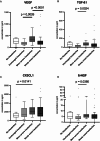Occurrence of new or more severe headaches following COVID-19 is associated with markers of microglial activation and peripheral sensitization: results from a prospective cohort study
- PMID: 38890625
- PMCID: PMC11186149
- DOI: 10.1186/s10194-024-01810-6
Occurrence of new or more severe headaches following COVID-19 is associated with markers of microglial activation and peripheral sensitization: results from a prospective cohort study
Abstract
Background: New onset or worsening of a headache disorder substantially contributes to the disease burden of post-COVID-19. Its management poses a suitable means to enhance patients' participation in professional, social, and personal activities. Unfortunately, the pathophysiology of post-COVID-19 headaches is poorly understood. This study aims to investigate the role of (neuro-) inflammatory mechanisms in order to guide the development of anti-inflammatory treatment strategies.
Methods: We included patients from the interdisciplinary post-COVID-19 Rehabilitation Study (PoCoRe, n = 184 patients) run at a tertiary care university hospital, comprising patients with PCR-confirmed SARS-CoV-2 infection ≥ 6 weeks prior to their initial consultation. Patients reporting any headache since their infection were considered for this study (n = 93). These were interviewed and classified according to the International Classification of Headache Disorders, Third Edition (ICHD-3) by headache specialists. Patient sera were additionally analysed for levels of VILIP-1, MCP-1 (CCL2), sTREM-2, BDNF, TGF-ß1, VEGF, IL-6, sTREM-1, ß-NGF, IL-18, TNF-alpha, sRAGE, and CX3CL1 (Fractalkine). Markers of inflammation were compared between four groups of patients (none, unchanged, worsened, or new headache disorder).
Results: Patients reported experiencing more severe headaches (n = 17), new onset headaches (n = 46), unchanged headaches (n = 18), and surprisingly, some patients denied having any headaches (n = 12) despite self-reports. Serum levels of CX3CL1 were increased in the worsened (2145 [811-4866] pg/ml) and new onset (1668 [0-7357] pg/ml) headache group as compared to patients with no (1129 [0-5379] pg/ml) or unchanged (1478 [346-4332] pg/ml) headaches. Other markers also differed between groups, but most significantly between patients with worsened (TGF-ß1: 60 [0-310] pg/ml, VEGF: 328 [86-842] pg/ml, ß-NGF: 6 [3-38] pg/ml) as compared to unchanged headaches (TGF-ß1: 29 [0-77] pg/ml, VEGF: 183 [72-380] pg/ml, ß-NGF: 3 [2-89] pg/ml). The results did not differ between headache phenotypes.
Discussion: This study provides evidence that worsened or new headaches following COVID-19 are associated with pro-(neuro-)inflammatory profiles. This supports the use of anti-inflammatory treatment options in this population, especially in the subacute phase.
Keywords: COVID-19; Headache; Inflammation; Migraine; New daily persistent headache; Sars-Cov-2.
© 2024. The Author(s).
Conflict of interest statement
The authors declare no competing interests.
Figures


References
MeSH terms
Substances
LinkOut - more resources
Full Text Sources
Medical
Research Materials
Miscellaneous

